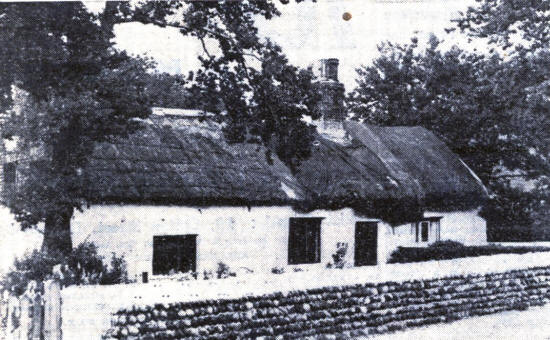Demolition of cottages, Commonside, Ansdell 1948.
---------------------------------------------------
OLD COTTAGES TO GIVE WAY TO ROAD
SCHEME
The march of progress is slow but inexorable. It
sweeps all before with neither feeling nor consideration. When progress takes
its next step in Lytham one of the last vestiges of the old town, the white
cottages in Commonside, Ansdell, will be removed from its path.
The cottages are scheduled for demolition and at
present the Clifton Estate, who own the cottages, are being consulted on a
proposed road improvement plan at Gordon Road.
Three years ago Dr. J. P. Litt, late medical officer
of health, condemned the cottages as unfit for habitation. The war and lack
of materials prevented the pulling down of the cottages there and then. Until
now they have been spared and may be spared for some little time yet, until
labour is available and fresh accommodation found for those occupying the
cottages.

These 200-years-old thatched cottages at Commonside are to come
down some time in the future to make way for a road improvement. They have been
condemned and a tarpaulin covers part of the roof of one cottage. There are now few
thatched houses in the Borough.
AGE
It has not been possible to establish the exact age
of the buildings. No deeds or plans for them exist, but it is known that they
are over 200 years old. There are plans in existence for buildings in this
area erected 200 years ago, so it is probable that the cottages are nearer
the 300 years mark.
Some of the timber contained in the structures,
three of which are occupied, is oak, and may have come from wreckage of
vessels plying in the River Ribble, as under the rights of wreck, land owners
often used wreckage found on the beaches of their land to help in
building.
The walls are known as the clay “clumped, stood,
raddled and daubed" type. This means that the clay was shaped into bricks
(clumped), the bricks were then placed in position (stood) then they were
cleaned off (raddled) and were finally daubed.
PAST GLORY
For the cottages, the days of the golden thatch are
gone Their heads of glory are now shrouded in water-proof tarpaulins and only
ragged, blackened ends of the old thatching are visible.
The roof on one of the old homesteads has fallen in
completely and in it birds are nesting and weeds growing. But the other
dwellings are quite sound and still draw- approving remarks from passers-by
seeing them for the first time. They constitute a sight rarely seen
now.
The cottages were built for workmen employed on the
lands of the Clifton Estate. Mrs. Annie Garside, daughter of John Cartmell, a
cowman with Squire Clifton for 30 years, still lives in one of the cottages
and has done so for 65 years, since she was three years old.
Her cottage contains photographs and other links
with the past glories of the Clifton family, of the Rossalls and Balls who
were among the oldest of the town's inhabitants. Mrs. Garside regales her
visitors with stories of the days that were, of George Dugdale arriving with
his sheath of knives to slaughter a pig and of 50Ib. hams hanging from the
beams. Of the times when people made their own entertainment and for whom
life was hard, but happy.
“SPLENDID HOMES"
Mrs. Garside, daughter of a Shropshire woman, has
her heart set as deep as her roots in the cottage which has been her home for
so long
She defied me and defies all to find one spot of
damp in the home, in spite of the thatched roof. “It will be a shame to pull
these cottages down." she said. “they are splendid homes.''
What will happen to the inhabitants of the cottages?
I learnt at the Town Hall that the cottages will not be pulled down until
further accommodation has been found for those living there now.
Furtherance of modern ideals demands that the
cottages go. It is for the ultimate benefit of the community and must be
regarded as a regrettable, but necessary evil.
Newspaper article dated 1948
|